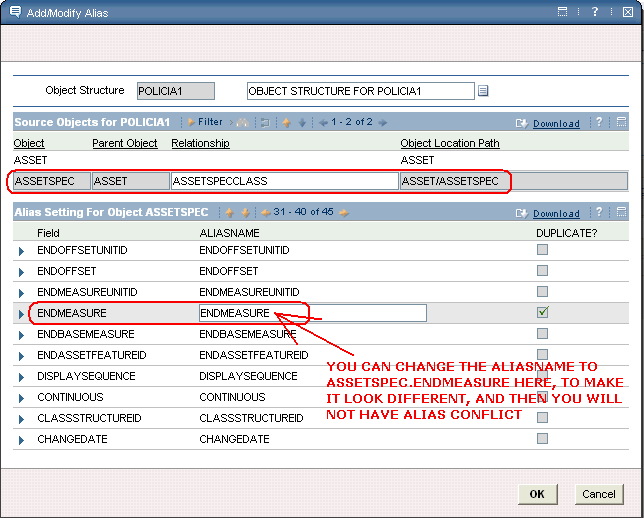Flashes (Alerts)
Abstract
If importing flat files, you may receive the error "BMXAA6138E = File cannot be imported. Enterprise Service's object structure {0} does not support flat structure or an alias conflict exists in one or more of its fields"
Content
Here is a checklist that you to follow to solve the error message "BMXAA6138E = File cannot be imported. Enterprise Service's object structure {0} does not support flat structure or an alias conflict exists in one or more of its fields" that is displayed at the moment you are importing data via flat files into Maximo, through Integration Interface (MEA).
On the Object Structure record being used by the Enterprise Services, on the External System, Support Flat Structure is selected. Remove any existing "Alias Conflict" on this Object Structure.


In this example, if you have an Object Structure calling the ASSET and ASSETSPEC objects, you will have alias conflicts, because some of the attributes from these two objects use the same alias information.
Go to Actions -> Add/Modify Alias. You will see that some fields are duplicated. In this case, they exist in both objects and their ALIASNAME information is equal to the field names. That causes the alias conflict.


In order to fix the alias conflicts on this object structure, you will need to change the ALIASNAME for all the duplicated fields that you can see for each object in the Add/Modify Alias dialog. You can change it to the objectname.attributename format, if you want. Make sure that the field/aliasname combination for all objects is unique. If they are not, your Object Structure will have alias conflict and you will get the error message importing flat files.
On the Object Structure record being used by the Enterprise Services, on the External System, Support Flat Structure is selected. Remove any existing "Alias Conflict" on this Object Structure.


In this example, if you have an Object Structure calling the ASSET and ASSETSPEC objects, you will have alias conflicts, because some of the attributes from these two objects use the same alias information.
Go to Actions -> Add/Modify Alias. You will see that some fields are duplicated. In this case, they exist in both objects and their ALIASNAME information is equal to the field names. That causes the alias conflict.


In order to fix the alias conflicts on this object structure, you will need to change the ALIASNAME for all the duplicated fields that you can see for each object in the Add/Modify Alias dialog. You can change it to the objectname.attributename format, if you want. Make sure that the field/aliasname combination for all objects is unique. If they are not, your Object Structure will have alias conflict and you will get the error message importing flat files.
Here is an example of how to do it for the ENDMEASURE field, but this is not the only field with alias conflict.

For this specific example, you will need to do the operation for all the following fields:
CHANGEBY
CHANGEDATE
CLASSSTRUCTUREID
ENDMEASURE
ORGID
STARTMEASURE
Then, after fixing all alias conflicts and saving the object structure record, the "Alias Conflict?" checkbox will be automatically cleared for the Object Structure record, and you will be able to import flat files without getting the error message. You just to make sure that the values for fields "Support Flat Structure" and "Alias Conflict" look like this. (see below).


For additional assistance, contact IBM Maximo Support.

For this specific example, you will need to do the operation for all the following fields:
CHANGEBY
CHANGEDATE
CLASSSTRUCTUREID
ENDMEASURE
ORGID
STARTMEASURE
Then, after fixing all alias conflicts and saving the object structure record, the "Alias Conflict?" checkbox will be automatically cleared for the Object Structure record, and you will be able to import flat files without getting the error message. You just to make sure that the values for fields "Support Flat Structure" and "Alias Conflict" look like this. (see below).


For additional assistance, contact IBM Maximo Support.
[{"Line of Business":{"code":"LOB59","label":"Sustainability Software"},"Business Unit":{"code":"BU059","label":"IBM Software w\/o TPS"},"Product":{"code":"SSLKT6","label":"IBM Maximo Asset Management"},"ARM Category":[{"code":"a8m50000000CbL4AAK","label":"Integration-\u003EObject Structures"}],"Platform":[{"code":"PF033","label":"Windows"}],"Version":"7.6.0;7.6.1","Type":"MASTER"},{"Line of Business":{"code":"LOB59","label":"Sustainability Software"},"Business Unit":{"code":"BU059","label":"IBM Software w\/o TPS"},"Product":{"code":"SSWT9A","label":"IBM Control Desk"},"ARM Category":[{"code":"a8m500000008b3EAAQ","label":"CCMDB Category (Change Management \u0026 Configuration Management)-\u003ECCMDB - Integration"}],"Platform":[{"code":"PF025","label":"Platform Independent"}],"Version":"7.5.0;7.6.0;7.6.1","Type":"MASTER"}]
Was this topic helpful?
Document Information
Modified date:
25 September 2022
UID
swg21381938